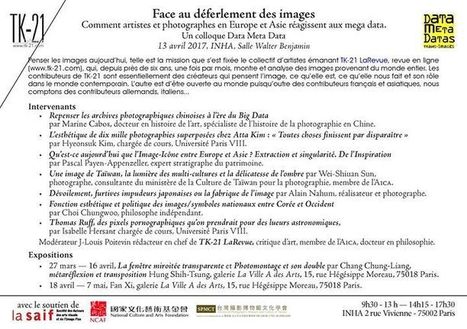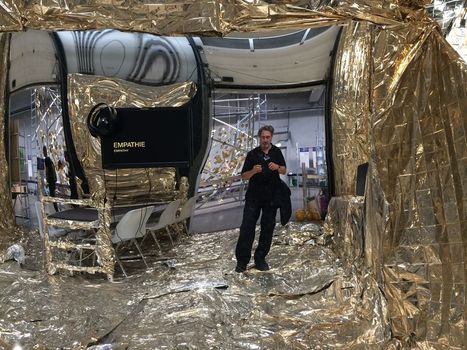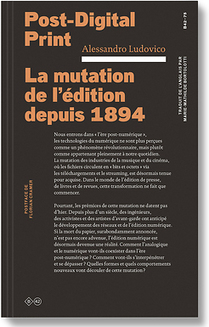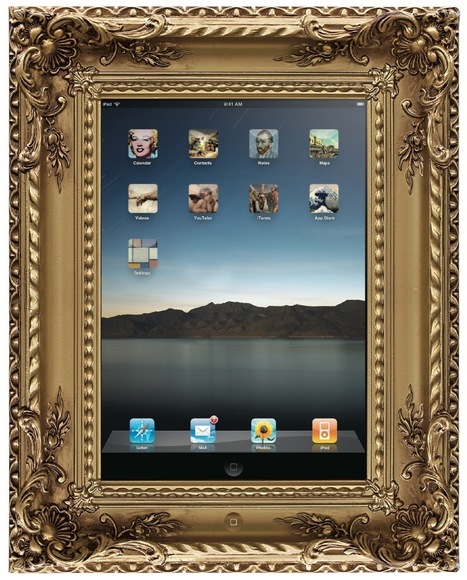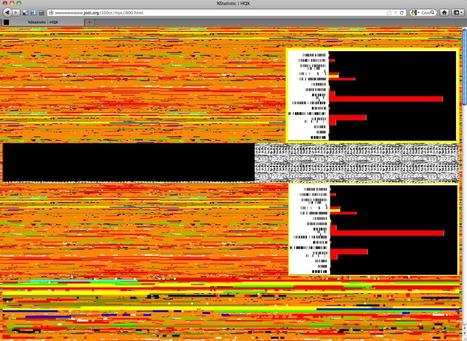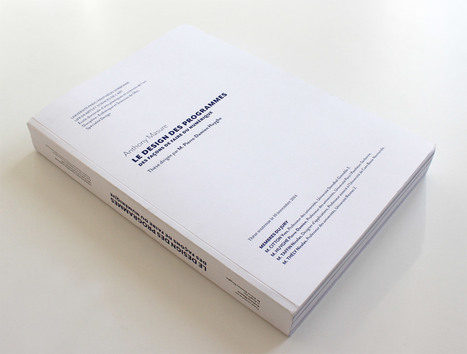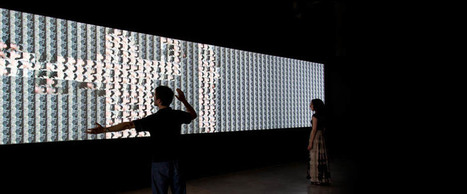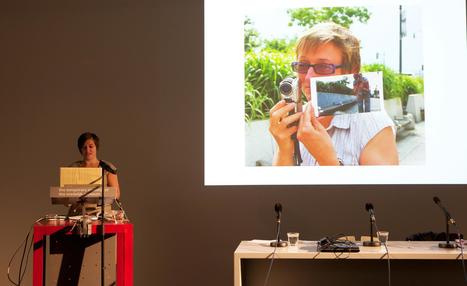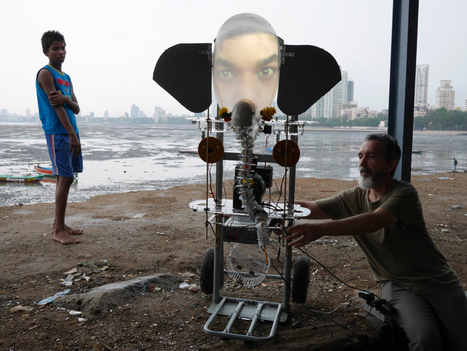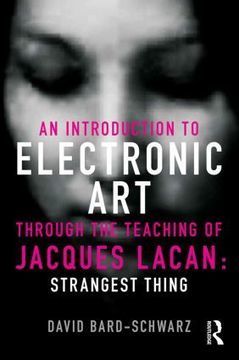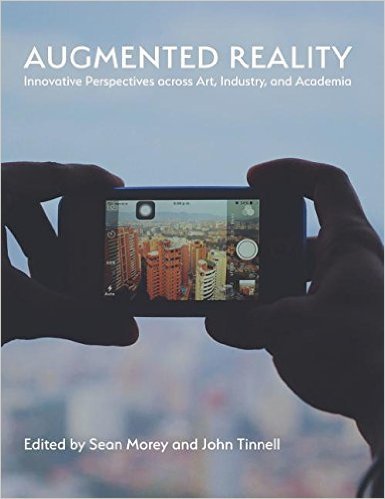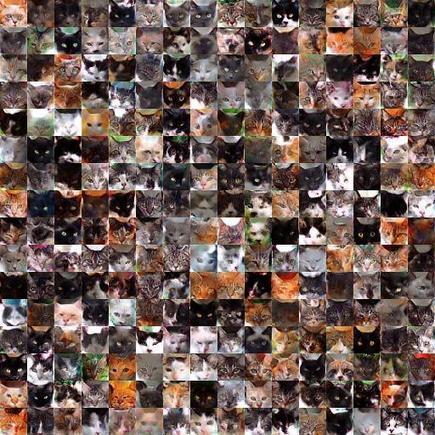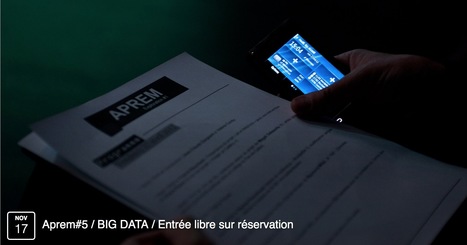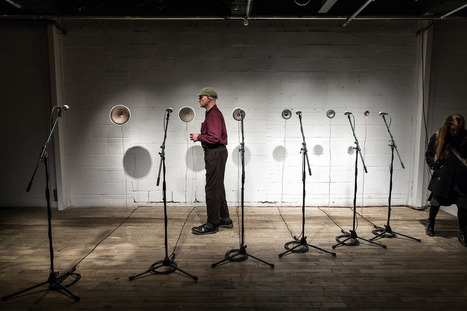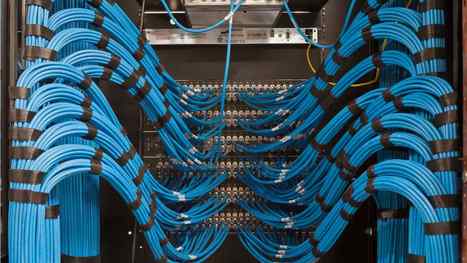 Your new post is loading...
 Your new post is loading...
Comment artistes et photographes en Europe et Asie réagissent aux mega data — Un colloque Data Meta Data
Un évènement TK-21 organisé avec le soutien de la SAIF, le National Culture and Arts Foundation (Taïwan) et la Society of Photographic Museum and Culture of Taïwan
http://www.tk-21.com
Intervenants
• Repenser les archives photographiques chinoises à l’ère du Big Data
par Marine Cabos, docteur en histoire de l’art, spécialiste de l’histoire de la photographie en Chine.
• L’esthétique de dix mille photographies superposées chez Atta Kim : « Toutes choses finissent par disparaître »
par Hyeonsuk Kim, chargée de cours, Université Paris VIII.
• Qu’est-ce aujourd’hui que l’Image-Icône entre Europe et Asie ? Extraction et singularité. De l’Inspiration
par Pascal Payen-Appenzeller, expert stratigraphe du patrimoine.
• Une image de Taïwan, la lumière des multi-cultures et la délicatesse de l’ombre par Wei-Shiuan Sun,
photographe, consultante du ministère de la Culture de Taïwan pour la photographie, membre de l’Aica.
• Dévoilement, furtives impudeurs japonaises ou la fabrique de l’image par Alain Nahum, réalisateur et photographe.
• Fonction esthétique et politique des images/symboles nationaux entre Corée et Occident
par Choi Chungwoo, philosophe indépendant.
• Thomas Ruff, des pixels pornographiques qu’on prendrait pour des lueurs astronomiques,
par Isabelle Hersant chargée de cours, Université Paris VIII.
Modérateur J-Louis Poitevin rédacteur en chef de TK-21 LaRevue, critique d’art, membre de l’Aica, docteur en philosophie.
In Educating Artists for the Future, some of the world’s most innovative thinkers about higher education in the arts offer fresh directions for educating artists and designers for a post-digital future. A group of artists, researchers, and teachers from a dozen countries here redefine art at the interdisciplinary interface where scientific inquiry and new technologies shape aesthetic values. This volume offers groundbreaking guidelines for art educators, demonstrating how the interplay between digital and cultural systems calls for alternative pedagogical strategies that encourage student-centered interactive learning. “Mel Alexenberg, a very sophisticated artist and scholar of much experience in the complex playing field of art-science-technology, addresses the rarely asked question: How does the ‘media magic’ communicate content?”—Otto Piene, Professor Emeritus and Director, Center for Advanced Visual Studies, Massachusetts Institute of Technology
This milestone volume maps fifty years of artists’ engagement with sound. Since the beginning of the new millennium, numerous historical and critical works have established Sound Art as an artistic genre in its own right, with an accepted genealogy that begins with Futurism, Dada, and Fluxus, as well as disciplinary classifications that effectively restrict artistic practice to particular tools and venues. This book, companion volume to a massive 2012-2013 exhibition at ZKM | Center for Art and Media, Karlsruhe, goes beyond these established disciplinary divides to chart the evolution and the full potential of sound as a medium of art.
The book begins with an extensive overview by volume editor and ZKM CEO Peter Weibel that considers the history of sound as media art, examining work by visual artists, composers, musicians, and architects alike. Subsequent essays examine sound experiments in antiquity, sonification of art and science, and Internet-based sound art. Experts then survey the global field of sound art research and practice, in essays that describe the past, present, and future of sound art in Germany, Japan, China, the United States, the United Kingdom, Russia, Canada, and Scandinavia. The texts are accompanied by hundreds of color images drawn from the ZKM exhibition. Essays by
Dmitry Bulatov, Seth Cluett, Christoph Cox, Ryo Ikeshiro, Caleb Kelly, Brandon LaBelle, Christof Migone, Tony Myatt, Irene Noy, Adam Parkinson, Bernd Schulz, Carsten Seiffarth, Linnea Semmerling, Başak Şenova, Morten Søndergaard, Alexandra Supper, Atau Tanaka, David Toop, Peter Weibel, Dajuin Yao, Siegfried Zielinski
A critical mapping of the multiplicities of Finnish artist and technology pioneer Erkki Kurenniemi—composer of electronic music, experimental filmmaker, inventor, collector, futurologist. Over the past forty years, Finnish artist and technology pioneer Erkki Kurenniemi (b. 1941) has been a composer of electronic music, experimental filmmaker, computer animator, roboticist, inventor, and futurologist. Kurenniemi is a hybrid—a scientist-humanist-artist. Relatively unknown outside Nordic countries until his 2012 Documenta 13 exhibition, ”In 2048,” Kurenniemi may at last be achieving international recognition. This book offers an excavation, a critical mapping, and an elaboration of Kurenniemi’s multiplicities.
The contributors describe Kurenniemi’s enthusiastic, and rather obsessive, recording of everyday life and how this archiving was part of his process; his exploratory artistic practice, with productive failure an inherent part of his method; his relationship to scientific and technological developments in media culture; and his work in electronic and digital music, including his development of automated composition systems and his “video-organ,” DIMI-O. A “Visual Archive,” a section of interviews with the artist, and a selection of his original writings (translated and published for the first time) further document Kurenniemi’s achievements. But the book is not just about one artist in his time; it is about emerging media arts, interfaces, and archival fever in creative practices, read through the lens of Kurenniemi.
Pier Luigi Capucci is an Italian educator, theorist and writer in the fields of media (both in communication and art realms) and of the relationships among culture, sciences and technologies, as well as an active contributor to the international debate about culture-sciences-technologies-arts. Since the early ‘80 Capucci has been concerned with the communication’s studies, the new media and the new art forms, and with the relations among arts, sciences and technologies. He has been professor at the Universities of Rome “La Sapienza”, Bologna, Florence, at SUPSI - University of Applied Sciences and Arts of Southern Switzerland, at the University of Urbino and at NABA in Milan. Currently he is a teacher at the Fine Art Academy of Urbino and in other institutions. Since 2008 he has been working as a supervisor in the (M)T-Node PhD Research Program of the Planetary Collegium (University of Plymouth), and in May 2013 he has been appointed as (M)T-Node's DoS (Director of Studies). His theoretical activity is concerned with the technologies of representation and communication, with the technoscience-based art forms, and with media archaeology studies. In the field of applied research he works on the opportunities of social relationships raised by online communications and new media.
How can we appreciate a Sense of Place in the space between the local and the global? Do our GIS technologies enhance or supress the psychology of distance that distinguishes between them and us in times of environmental crisis? Are we making sense of our remote sensors in our telematic umwelt? Virtual simulations create powerful immersive experiences, but are they just distracting us from the complexities of feeling the volatile environment? Do we have the mental dexterity and visual literacy to comprehend these trasnscalar networked ecologies? From the overview to the nanoscape, BunB 2017 will critically explore our (missing) Sense of Place.
A Sense of Place aims to provoke discussion, reflection and action to address the imminent social, economic and cultural impact of climate change. Balance-Unbalance cultivates transdisciplinary relationships and initiatives which seek to provide insights, awareness, innovation, behaviour change and resolutions. To achieve these ambitions Balance-Unbalance explores innovative art and technology practices that provide new models which enhance participation, public engagement, information literacy and ecological action. Deadline for submissions: January 16, 2017
Nous entrons dans « l’ère post-numérique », les technologies du numérique ne sont plus perçues comme un phénomène révolutionnaire, mais plutôt comme appartenant pleinement à notre quotidien. La mutation des industries de la musique et du cinéma, où les fichiers circulent en « bits et octets » via les téléchargements et le streaming, est désormais tenue pour acquise. Dans le monde de l’édition de presse, de livres et de revues, cette transformation ne fait que commencer.
Pourtant, les prémices de cette mutation ne datent pas d’hier. Depuis plus d’un siècle, des ingénieurs, des activistes et des artistes d’avant-garde ont anticipé le développement des réseaux et de l’édition numérique. Si la mort du papier, surabondamment annoncée, n’est pas encore advenue, l’édition numérique est désormais devenue une réalité. Comment l’analogique et le numérique vont-ils coexister dans l’ère post-numérique ? Comment vont-ils s’interpénétrer et se dépasser ? Quelles formes et quels comportements nouveaux vont découler de cette mutation ?
Cet ouvrage est publié avec le soutien du Centre national du livre et de la région Ile-de-France.
It’s lunchtime in Diego Garcia and still dark in the Mid-Atlantic, but the first light of day is reflecting hard white off the former Google facility in Hamina, Finland. The cameras on BLIX and RITTER, the twin UNDATA satellites I'm flying over Europe’s Eastern border, trigger automatically. My shift’s first images appear on the monitor, overlays shimmering to life atop the decommissioned data center, outlining stacks of disassembled routers and cooling vents. The progress bar on the ops room’s jumbotron starts to fill. All green so far. The threat graph is bottomed-out today; the Finns have tightened up border security following several incursions by FSB and Spetssvyaz looters. But everything that was there yesterday is still there today. I take a moment to examine the traffic: dumper trucks heading towards Russia and the M10, the usual overnight flights nosing down from North America, the expected chatter in the ionosphere. Nothing to see here. The overview moves toward the Baltic States before swinging back up again, towards Sweden and the old Facebook plant. ... Personal data is anything but personal. Our phones and televisions listen in on us; the most powerful corporations in the world trade in consumer tics, browsing histories, and demographic identities. James Bridle is an artist and technologist whose work addresses issues of privacy, surveillance, and security; he coined the term "New Aesthetic" to describe the way the visual language of technology has begun to seep into the physical world. This is his first work of fiction. -The Eds
This text has been written for the proceedings of the international conference "New Perspectives, New Technologies", organized by the Doctoral School Ca' Foscari - IUAV in Arts History and held in Venice and Pordenone, Italy in October 2011 In the late nineties and during the first decade of this century the term “new media art” became the established label for that broad range of artistic practices that includes works that are created, or in some way deal with, new media technologies. Providing a more detailed definition here would inevitably mean addressing topics beyond the scope of this paper, that I discussed extensively in my book Media, New Media, Postmedia (Quaranta 2010). By way of introduction to the issues discussed in this paper, we can summarize the main argument put forward in the book: that this label, and the practices it applies to, developed mostly in an enclosed social context, sometimes called the “new media art niche”, but that would be better described as an art world in its own right, with its own institutions, professionals, discussion platforms, audience, and economic model, and its own idea of what art is and should be; and that only in recent years has the practice managed to break out of this world, and get presented on the wider platform of contemporary art. ...
The University of Washington and Microsoft Research are making big investments in uncategorizable, emerging-media work. What are their artists stumbling upon? Not long ago, during an exclusive reception for donors to the University of Washington's College of Arts & Sciences, a handful of student artists were invited to present their works. When it came time for a piece by Robert Twomey, a PhD candidate in the university's emerging-technology department called DXARTS, one donor responded viciously, openly declaring his art "an abomination." The art was a machine that makes drawings. The donor was a woman trained in painting and printmaking, a die-hard believer in the importance of the hand of the artist. "But there's no one behind it!" she exclaimed.
"But I am behind it," said Twomey. She gave him her name and number and the impression that she'd like to cure him of an affliction. Twomey kept trying to explain that he was a painter at heart, that they were on the same side...
The importance of net.art will never be adequately addressed while the history of art is written by the museums, galleries and the market. Many artists affiliated with this 1990s art movement deliberately used the Internet to circumvent the machinery of the art world or made works that are difficult if not impossible to exhibit and sell. But net.art still offers an essential critique of our relationship to the Internet as well as a compelling demonstration of how art can challenge it from within. Recognising that the dust has not yet settled, curator and critic Domenico Quaranta composed four short hypotheses about net.art built around the Introduction to net.art (1994–1999) by artists Natalie Bookchin and Alexei Shulgin in 1999.
In a shared online document, four artists and artist groups who helped shape the course of net.art – UBERMORGEN, JODI, Vuk Cosic, and Olia Lialina – respond with their own take on what happened.
Cette thèse interroge le design depuis les pratiques de programmation en montrant qu’elles ne se réduisent pas à une industrie des programmes, qui empêche les inventions de naître tout à fait. Pour cela, elle confronte au sein d’une lecture non linéaire cinq moments de l’histoire du numérique (depuis Vannevar Bush en 1945, dont une traduction inédite est proposée en appendice, jusqu’aux usages contemporains du site web GitHub) à quatre formulations conceptuelles issues d’un corpus philosophique. Le choix d’auteurs qui n’ont pas directement voué leurs réflexions au design (comme Jacques Derrida, Hannah Arendt ou Walter Benjamin) permet de déconstruire un certain nombre de discours entourant la réception des technologies dites nouvelles. Critiquant nombre d’usages faits des notions de conception et de projet et s’appuyant finalement sur Gilbert Simondon, cette thèse s’intéresse à ce qui n’est pas prévisible dans les programmes. Elle soutient cinq axes ou directions pour une recherche dans le champ concerné : décentrer, authentifier, appareiller, traduire et désarticuler. La plausibilité de ces façons de faire du numérique, encore à l’état d’ébauche dans les productions contemporaines, peut intéresser les designers au-delà des spécialistes. Elle est avérée en fin d’ouvrage dans la description d’une fiction curatoriale. Thèse dirigée par M. Pierre-Damien Huyghe. Université Paris 1 Panthéon-Sorbonne, ufr 04, École doctorale d’arts plastiques et sciences de l’art. Discipline : Esthétique et Sciences de l’Art, spécialité Design. 550 pages, 1 200 000 signes, 923 notes de bas de page et 266 figures.
The Conservation Center’s Topics in Time-Based Media Art Conservation lecture series takes place on Mondays during the 2016 Fall semester and is generously supported by the Andrew W. Mellon Foundation. The list of presentations is given below. A video of each lecture will be archived and available after the event in the Institute's video archive.
Please note that seating is very limited. While these events are open to the public, we require an RSVP through our mailing list followed by a confirmation. If you sign up for our Time-Based Media Art Conservation mailing list, you will receive an invitation to RSVP well in advance of each event listed below. Please sign up here.
|
Building on research into curating new media art since 1993 at the University of Sunderland, CRUMB was founded by Beryl Graham and Sarah Cook in 2000 within the School of Arts, Design, Media and Culture, with a Small Grant from the Arts and Humanities Research Board. CRUMB's activities cover a range of practices, but are predominantly based around research, networking, and professional development for curators of new media art.
CRUMB members run a lively discussion list on curating new media art with over 1000 international subscribers, publish interviews with curators, and lecture and publish widely, contributing to academic books as well as artists' exhibition catalogues. Articles written by CRUMB team members on the subject of curating new media art are to be found in books published by Routledge, Arts Council of England, University of California Press and The Banff Centre Press and in periodicals such as Leonardo, Art Monthly and Mute Magazine. Cook and Graham's book Rethinking Curating: Art After New Media was published by MIT Press in 2010 and is the leading text in the field. CRUMB is supported by the University of Sunderland with funding from the Arts and Humanities Research Council, The Leverhulme Trust, Arts Council England.
La co-présence des robots commence à être une réalité. Dans cet ouvrage qui leur est consacré, Paul Dumouchel et Luisa Damiano analysent les points cruciaux des relations avec ces créatures artificielles dotées de compétences sociales. Au contraire des autres objets techniques omniprésents mais le plus souvent considérés comme invisibles, conçus pour fonctionner dans un environnement façonné, contrôlé et occupé par l’homme, les robots sont les nouveaux acteurs d’une transformation technique, sociale et culturelle. Cet ouvrage est une introduction à ce projet de co-évolution, d’où serait susceptible de surgir de nouvelles formes de socialité, l’empathie artificielle étant un enjeu majeur de leur rôle annoncé.
Electronic art offers endless opportunities for reflection and interpretation. Some works are either interactive or entirely autonomous, and the viewer's perception and reaction to them may be challenged by constantly transforming images. Whether the transformations are a product of the appearances or actions of a viewer in an installation space, or a product of a self-contained computer program, is a source of constant fascination. Some viewers may feel strange or unnerved by a work, while others may feel welcoming, humorous, and playful emotions. The art may also provoke a critical response to social, aesthetic, and political aspects of early twenty-first century life. This book approaches electronic art through the teachings of Jacques Lacan, whose return to Freud has exerted a powerful and wide-ranging influence on psychoanalysis and critical theory in the twentieth century.
Augmented Reality: Innovative Perspectives across Art, Industry, and Academia offers a wide-ranging exploration of the implications, challenges, and promises of augmented reality. Traditionally only covered from a technical perspective, augmented reality has become an increasingly important area of cultural inquiry in humanities scholarship and popular media outlets. This collection attempts to cross-pollinate the discourse, creating a multidisciplinary exchange among leading researchers and professionals who each advance different ways of understanding current (and future) forms of augmented reality. Another underlying mission is to bring critical reflection and artistic ingenuity into conversation with design thinking and software development. To that end, the collection features a mix of essays from humanities scholars, artworks by pathbreaking artists, as well as interviews with software developers and industry consultants. Among the first of its kind, the book also incorporates augmented reality into its own design by placing relevant digital content within the printed page using Aurasma.
The influence of play and aesthetic distance in interactive art encounters... During this research many different people in a variety of places supported me and inspired me, directly or indirectly influencing this text. First and foremost I would like to thank Julie Staebler, my life companion, who constantly supported me from the earliest stages of planning this research until its realization. I would like to acknowledge in particular her patience and comprehension regarding my absent-mindedness but also the wise advice she gave me along the way. Another person who was always present is Patrícia Gouveia, my supervisor. I’m very grateful for all the good discussions we had and for all the precious feedback I was given from the early days of this research. Patrícia was also very encouraging and supportive regarding my research path and academic adventures abroad. ...
From the invention of the press, to the elevator, acrylic paint, and the electric guitar, technological progress has helped drive changes in ancient art forms (in these cases, literature, architecture, painting, and music). But sometimes entirely new art forms (such as the movies) spring from new technologies. In A Philosophy of Computer Art, Lopes argues that computer art is a new art form. While it is true that digital encoding is having an enormous impact on traditional arts, the essence of the computer is not digital encoding. Rather, computers run computational processes or algorithms that enable them to modify a display based on input. Computer art takes advantage of this to achieve interactivity, where the audience of a work has a part to play in how the work unfolds. Billions of people already know computer art through video games, and Lopes shows how highbrow computer artists work with the same basic materials and opportunities as video game designers.
In a global economic landscape of hyper-commodification and financialisation, efforts to assimilate digital art into the high-stakes commercial art market have so far been rather unsuccessful, presumably because digital artworks cannot easily assume the status of precious object worthy of collection. This essay explores the use of blockchain technologies in attempts to create proprietary digital art markets in which uncommodifiable digital artworks are financialised as artificially scarce commodities. Using the decentralisation techniques and distributed database protocols underlying current cryptocurrency technologies, such efforts, exemplified here by the platform Monegraph, tend to be presented as concerns with the interest of digital artists and with shifting ontologies of the contemporary work of art. I challenge this characterisation, and argue, in a discussion that combines aesthetic theory, legal and philosophical theories of intellectual property, rhetorical analysis and research in the political economy of new media, that the formation of proprietary digital art markets by emerging commercial platforms such as Monegraph constitutes a worrisome amplification of long-established, on-going efforts to fence in creative expression as private property. As I argue, the combination of blockchain-based protocols with established ambitions of intellectual property policy yields hybrid conceptual-computational financial technologies (such as self-enforcing smart contracts attached to digital artefacts) that are unlikely to empower artists but which serve to financialise digital creative practices as a whole, curtailing the critical potential of the digital as an inherently dynamic and potentially uncommodifiable mode of production and artistic expression. ...
The Daniel Langlois Foundation is pleased to make available the conferences held as part of its exhibition Communicating Vessels - e-art: New Technologies and Contemporary Art, presented at the Montreal Museum of Fine Arts in the fall of 2007. These conferences, led by Jean Gagnon, Anne-Marie Duguet, Jim Campbell, David Rokeby, Lynn Hershman Leeson, Olivier Asselin, Cornelius Bork and Ernestine Daubner, are now accessible via this Web site. How can we understand art that is being reinvented in the digital age? Today, art has gone beyond the limitations of traditional practices; it is created at the cutting edge of disciplines that not only interconnect but are continually evolving. How, then, do we position ourselves as visitors? How do we grasp the meaning of these new works of art in exhibition spaces that are themselves being utterly transformed? How do the creators of this art – who are now engineers, philosophers and computer specialists as well as artists – design a way of working that can take place equally well in a laboratory or a studio? Hear some of the artists and researchers who are presently the most involved in these questions.
Le neural.net est laplacien parce qu’il prévoit en calculant la possibilité d’une récurrence (Nitish Srivastava, Elman Mansimov, Ruslan Salakhutdinov, 16 feb 2015). En ce sens, il apparaît contradictoire avec l’hyperchaos et la contingence. En se fondant sur des grands ensembles de données (les datasets) accumulés sur les réseaux sociaux, le RNN déduit ce qui va pouvoir être. Il vectorise pour se faire des documents qui en tant qu’inscription sont passés. Cette vectorisation permet d’éviter de manipuler des symboles sémantiques et se limite donc aux mathématiques. La contingence n’a pas lieu d’être avec le RNN parce qu’elle n’a jamais eu lieu. Elle n’est pas d’autres lois, elle est hors-la-loi, sans loi.
Nous définissons le « big data » comme la constitution et l'exploitation des traces numériques produites par delà la Planète dans son ensemble. APREM#5 DU 17 AU 19 NOVEMBRE
BIG DATA
à la Fabrique de Théâtre de15h à 22h
FB event : https://www.facebook.com/events/1585220878170242
Cette collecte de données se produit évidemment sur les réseaux dits sociaux mais également au travers de la plupart des outils du World Wide Web : sites d'achat en ligne, clients de serveurs de mail, sites de presse ou de jeux en ligne. Elle se produit également au travers du « self-quantify » : pèses-personne connectés, applications mobiles de suivi des performances sportives, plate-formes de suivi de la consommation énergétique du logement....
+++++++++++
Pour y voir plus clair, nous y accueillerons, entre autres :
Valérie Cordy, Jean-Claude Dargeant, Samuel Bianchini, La Quincaillerie Moderne,Nicolas Maigret, Nicolas Rosette, Jacques Perconte, Le projet OpenBeeLab, Isabelle Humbert-Radtke, Le Mundaneum, Adrien Colrat, Pierre Hemptinne, Le collectif InOutput, Lucille Calmel, RYBN, Eric Guichard...
Adam Basanta is a sound artist, composer and performer based in Montreal. His sculptural sound installations are minimalistic choreographies of speakers and microphones, replicating real or imagined scenarios of listening. These installations operate around an alternative perception of sound, through attuning to sensations that are not necessarily perceived by the human ear — and through recognising that what may appear to be empty space is full of sonic phenomena that is material. Basanta may translate statistical information — a dossier that documents geospatial, and thus social, patterns in movement between cities — by codifying it into a different medium than we are accustomed to reading. Information is processed not through text or image, but through sound, as in the documentation of domestic and international flights of Going Nowhere Fast. By making audible the ratios, lengths or repetitions of individual travel, raw data attains a curious musicality. ...
Edito : Attentive aux plus récentes manifestations de l’imaginaire contemporain et soucieuse d’en saisir les fondements historiques et théoriques, Captures est la toute nouvelle et première revue à comité de pairs de Figura, le Centre de recherche sur le texte et l’imaginaire. Sa création est source de grande fierté. Dédiée à la publication de travaux consacrés à l’analyse de problématiques liées aux figures, théories et pratiques de l’imaginaire, sans limitations territoriales ou nationales, située à la croisée des études littéraires et cinématographiques, des sciences humaines, de l'histoire de l'art, des arts visuels et médiatiques, Captures se veut une pièce maîtresse de la diffusion internationale de la recherche menée au Centre. La revue exploite résolument les ressources du Web en publiant des numéros évolutifs, ouverts à des enrichissements continus et périphériques à chaque parution, et dont les contenus sont intégrés aux environnements de recherches et de connaissances mis en ligne par Figura. Assumant pleinement la mutabilité de son support, Captures aspire à renouveler les formes de la revue savante...
|
 Your new post is loading...
Your new post is loading...
 Your new post is loading...
Your new post is loading...




